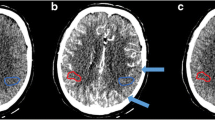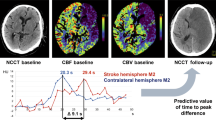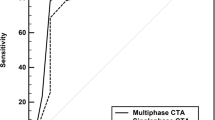Abstract
Introduction
Factors that determine the extent of the penumbra in the initial diagnostic workup using whole brain CT Perfusion (WB-CTP) remain unclear. The purpose of the current study was to determine a possible dependency of the initial mismatch size between cerebral blood flow (CBF) and cerebral blood volume (CBV) from time after symptom onset, leptomeningeal collateralization, and occlusion localization in acute middle cerebral artery (MCA) infarctions.
Methods
Out of an existing cohort of 992 consecutive patients receiving multiparametric CT scans including WB-CTP due to suspected stroke, we included patients who had (1) a witnessed time of symptom onset, (2) an infarction of the MCA territory as documented by follow-up imaging, and (3) an initial CBF volume of >10 ml. CBF and CBV lesion sizes, collateralization grade, and the site of occlusion were determined.
Results
We included 103 patients. Univariate analysis showed that time from symptom onset (168 +/− 91.2 min) did not correlate with relative or absolute mismatch volumes (p = 0.458 and p = 0.921). Higher collateralization gradings were associated with small absolute mismatch volumes (p = 0.004 and p < 0.001). Internal carotid artery (ICA) occlusions were associated with large absolute mismatch volumes (p = 0.004). Multivariate analysis confirmed that ICA occlusion was associated with large absolute mismatch volumes (p = 0.005), and high collateral grade was associated with small absolute mismatch volumes (p = 0.017).
Conclusions
There is no significant correlation between initial CTP mismatch and time after symptom onset. Predictors of mismatch size include the extent of the collaterals and a proximal location of the occlusion.



Similar content being viewed by others
References
Jones TH, Morawetz RB, Crowell RM, Marcoux FW, FitzGibbon SJ, DeGirolami U, Ojemann RG (1981) Thresholds of focal cerebral ischemia in awake monkeys. J Neurosurg 54(6):773–782. doi:10.3171/jns.1981.54.6.0773
Abou-Chebl A (2010) Endovascular treatment of acute ischemic stroke may be safely performed with no time window limit in appropriately selected patients. Stroke 41(9):1996–2000. doi:10.1161/STROKEAHA.110.578997
Saver JL (2006) Time is brain--quantified. Stroke 37(1):263–266. doi:10.1161/01.STR.0000196957.55928.ab
Khatri P, Abruzzo T, Yeatts SD, Nichols C, Broderick JP, Tomsick TA, Ims I, Investigators II (2009) Good clinical outcome after ischemic stroke with successful revascularization is time-dependent. Neurology 73(13):1066–1072. doi:10.1212/WNL.0b013e3181b9c847
Hacke W, Kaste M, Fieschi C, von Kummer R, Davalos A, Meier D, Larrue V, Bluhmki E, Davis S, Donnan G, Schneider D, Diez-Tejedor E, Trouillas P (1998) Randomised double-blind placebo-controlled trial of thrombolytic therapy with intravenous alteplase in acute ischaemic stroke (ECASS II). Second European-Australasian acute stroke study investigators. Lancet 352(9136):1245–1251
Emberson J, Lees KR, Lyden P, Blackwell L, Albers G, Bluhmki E, Brott T, Cohen G, Davis S, Donnan G, Grotta J, Howard G, Kaste M, Koga M, von Kummer R, Lansberg M, Lindley RI, Murray G, Olivot JM, Parsons M, Tilley B, Toni D, Toyoda K, Wahlgren N, Wardlaw J, Whiteley W, Del Zoppo GJ, Baigent C, Sandercock P, Hacke W, for the Stroke Thrombolysis Trialists' Collaborative G, (2014) Effect of treatment delay, age, and stroke severity on the effects of intravenous thrombolysis with alteplase for acute ischaemic stroke: a meta-analysis of individual patient data from randomised trials. Lancet. doi:10.1016/S0140-6736(14)60584-5
Jauch EC, Saver JL, Adams HP Jr, Bruno A, Connors JJ, Demaerschalk BM, Khatri P, McMullan PW Jr, Qureshi AI, Rosenfield K, Scott PA, Summers DR, Wang DZ, Wintermark M, Yonas H, American Heart Association Stroke C, Council on Cardiovascular N, Council on Peripheral Vascular D, Council on Clinical C (2013) Guidelines for the early management of patients with acute ischemic stroke: a guideline for healthcare professionals from the American Heart Association/American Stroke Association. Stroke 44(3):870–947. doi:10.1161/STR.0b013e318284056a
Adeoye O, Hornung R, Khatri P, Kleindorfer D (2011) Recombinant tissue-type plasminogen activator use for ischemic stroke in the United States: a doubling of treatment rates over the course of 5 years. Stroke 42(7):1952–1955. doi:10.1161/STROKEAHA.110.612358
de Los Rios la Rosa F, Khoury J, Kissela BM, Flaherty ML, Alwell K, Moomaw CJ, Khatri P, Adeoye O, Woo D, Ferioli S, Kleindorfer DO (2012) Eligibility for intravenous recombinant tissue-type plasminogen activator within a population: the effect of the European Cooperative acute stroke study (ECASS) III trial. Stroke 43(6):1591–1595. doi:10.1161/STROKEAHA.111.645986
Asplund K, Sukhova M, Wester P, Stegmayr B (2015) Diagnostic procedures, treatments, and outcomes in stroke patients admitted to different types of hospitals. Stroke 46(3):806–812. doi:10.1161/STROKEAHA.114.007212
Vagal A, Meganathan K, Kleindorfer DO, Adeoye O, Hornung R, Khatri P (2014) Increasing use of computed tomographic perfusion and computed tomographic angiograms in acute ischemic stroke from 2006 to 2010. Stroke 45(4):1029–1034. doi:10.1161/STROKEAHA.113.004332
Wintermark M, Flanders AE, Velthuis B, Meuli R, van Leeuwen M, Goldsher D, Pineda C, Serena J, van der Schaaf I, Waaijer A, Anderson J, Nesbit G, Gabriely I, Medina V, Quiles A, Pohlman S, Quist M, Schnyder P, Bogousslavsky J, Dillon WP, Pedraza S (2006) Perfusion-CT assessment of infarct core and penumbra: receiver operating characteristic curve analysis in 130 patients suspected of acute hemispheric stroke. Stroke 37(4):979–985. doi:10.1161/01.STR.0000209238.61459.39
Campbell BC, Purushotham A, Christensen S, Desmond PM, Nagakane Y, Parsons MW, Lansberg MG, Mlynash M, Straka M, De Silva DA, Olivot JM, Bammer R, Albers GW, Donnan GA, Davis SM (2012) The infarct core is well represented by the acute diffusion lesion: sustained reversal is infrequent. J Cereb Blood Flow Metab 32(1):50–56. doi:10.1038/jcbfm.2011.102
De Silva DA, Churilov L, Olivot JM, Christensen S, Lansberg MG, Mlynash M, Campbell BC, Desmond P, Straka M, Bammer R, Albers GW, Davis SM, Donnan GA (2011) Greater effect of stroke thrombolysis in the presence of arterial obstruction. Ann Neurol 70(4):601–605. doi:10.1002/ana.22444
Schaefer PW, Barak ER, Kamalian S, Gharai LR, Schwamm L, Gonzalez RG, Lev MH (2008) Quantitative assessment of core/penumbra mismatch in acute stroke: CT and MR perfusion imaging are strongly correlated when sufficient brain volume is imaged. Stroke 39(11):2986–2992. doi:10.1161/STROKEAHA.107.513358
Murayama K, Katada K, Nakane M, Toyama H, Anno H, Hayakawa M, Ruiz DS, Murphy KJ (2009) Whole-brain perfusion CT performed with a prototype 256-detector row CT system: initial experience. Radiology 250(1):202–211. doi:10.1148/radiol.2501071809
Thierfelder KM, Sommer WH, Baumann AB, Klotz E, Meinel FG, Strobl FF, Nikolaou K, Reiser MF, von Baumgarten L (2013) Whole-brain CT perfusion: reliability and reproducibility of volumetric perfusion deficit assessment in patients with acute ischemic stroke. Neuroradiology 55(7):827–835. doi:10.1007/s00234-013-1179-0
Abou-Chebl A, Lin R, Hussain MS, Jovin TG, Levy EI, Liebeskind DS, Yoo AJ, Hsu DP, Rymer MM, Tayal AH, Zaidat OO, Natarajan SK, Nogueira RG, Nanda A, Tian M, Hao Q, Kalia JS, Nguyen TN, Chen M, Gupta R (2010) Conscious sedation versus general anesthesia during endovascular therapy for acute anterior circulation stroke: preliminary results from a retrospective, multicenter study. Stroke 41(6):1175–1179. doi:10.1161/STROKEAHA.109.574129
Almekhlafi MA, Demchuk AM, Mishra S, Bal S, Menon BK, Wiebe S, Clement FM, Wong JH, Hill MD, Goyal M (2013) Malignant emboli on transcranial Doppler during carotid stenting predict postprocedure diffusion-weighted imaging lesions. Stroke 44(5):1317–1322. doi:10.1161/STROKEAHA.111.000659
Broderick JP, Palesch YY, Demchuk AM, Yeatts SD, Khatri P, Hill MD, Jauch EC, Jovin TG, Yan B, Silver FL, von Kummer R, Molina CA, Demaerschalk BM, Budzik R, Clark WM, Zaidat OO, Malisch TW, Goyal M, Schonewille WJ, Mazighi M, Engelter ST, Anderson C, Spilker J, Carrozzella J, Ryckborst KJ, Janis LS, Martin RH, Foster LD, Tomsick TA (2013) Endovascular therapy after intravenous t-PA versus t-PA alone for stroke. N Engl J Med 368(10):893–903. doi:10.1056/NEJMoa1214300
Kidwell CS, Jahan R, Gornbein J, Alger JR, Nenov V, Ajani Z, Feng L, Meyer BC, Olson S, Schwamm LH, Yoo AJ, Marshall RS, Meyers PM, Yavagal DR, Wintermark M, Guzy J, Starkman S, Saver JL, Investigators MR (2013) A trial of imaging selection and endovascular treatment for ischemic stroke. N Engl J Med 368(10):914–923. doi:10.1056/NEJMoa1212793
Menon BK, Smith EE, Modi J, Patel SK, Bhatia R, Watson TW, Hill MD, Demchuk AM, Goyal M (2011) Regional leptomeningeal score on CT angiography predicts clinical and imaging outcomes in patients with acute anterior circulation occlusions. AJNR Am J Neuroradiol 32(9):1640–1645. doi:10.3174/ajnr.A2564
Liebeskind DS, Tomsick TA, Foster LD, Yeatts SD, Carrozzella J, Demchuk AM, Jovin TG, Khatri P, von Kummer R, Sugg RM, Zaidat OO, Hussain SI, Goyal M, Menon BK, Al Ali F, Yan B, Palesch YY, Broderick JP, Investigators II (2014) Collaterals at angiography and outcomes in the interventional management of stroke (IMS) III trial. Stroke 45(3):759–764. doi:10.1161/STROKEAHA.113.004072
Nambiar V, Sohn SI, Almekhlafi MA, Chang HW, Mishra S, Qazi E, Eesa M, Demchuk AM, Goyal M, Hill MD, Menon BK (2014) CTA collateral status and response to recanalization in patients with acute ischemic stroke. AJNR Am J Neuroradiol 35(5):884–890. doi:10.3174/ajnr.A3817
Fiehler J, Kucinski T, Knudsen K, Rosenkranz M, Thomalla G, Weiller C, Rother J, Zeumer H (2004) Are there time-dependent differences in diffusion and perfusion within the first 6 hours after stroke onset? Stroke 35(9):2099–2104. doi:10.1161/01.STR.0000138450.15078.b5
Copen WA, Rezai Gharai L, Barak ER, Schwamm LH, Wu O, Kamalian S, Gonzalez RG, Schaefer PW (2009) Existence of the diffusion-perfusion mismatch within 24 hours after onset of acute stroke: dependence on proximal arterial occlusion. Radiology 250(3):878–886. doi:10.1148/radiol.2503080811
Sorensen AG, Copen WA, Ostergaard L, Buonanno FS, Gonzalez RG, Rordorf G, Rosen BR, Schwamm LH, Weisskoff RM, Koroshetz WJ (1999) Hyperacute stroke: simultaneous measurement of relative cerebral blood volume, relative cerebral blood flow, and mean tissue transit time. Radiology 210(2):519–527. doi:10.1148/radiology.210.2.r99fe06519
Neumann-Haefelin T, Wittsack HJ, Wenserski F, Siebler M, Seitz RJ, Modder U, Freund HJ (1999) Diffusion- and perfusion-weighted MRI. The DWI/PWI mismatch region in acute stroke. Stroke 30(8):1591–1597
Darby DG, Barber PA, Gerraty RP, Desmond PM, Yang Q, Parsons M, Li T, Tress BM, Davis SM (1999) Pathophysiological topography of acute ischemia by combined diffusion-weighted and perfusion MRI. Stroke 30(10):2043–2052
Gonzalez RG, Hakimelahi R, Schaefer PW, Roccatagliata L, Sorensen AG, Singhal AB (2010) Stability of large diffusion/perfusion mismatch in anterior circulation strokes for 4 or more hours. BMC Neurol 10:13. doi:10.1186/1471-2377-10-13
Hakimelahi R, Vachha BA, Copen WA, Papini GD, He J, Higazi MM, Lev MH, Schaefer PW, Yoo AJ, Schwamm LH, Gonzalez RG (2014) Time and diffusion lesion size in major anterior circulation ischemic strokes. Stroke 45(10):2936–2941. doi:10.1161/STROKEAHA.114.005644
Campbell BC, Christensen S, Levi CR, Desmond PM, Donnan GA, Davis SM, Parsons MW (2012) Comparison of computed tomography perfusion and magnetic resonance imaging perfusion-diffusion mismatch in ischemic stroke. Stroke 43(10):2648–2653. doi:10.1161/STROKEAHA.112.660548
Lin L, Bivard A, Levi CR, Parsons MW (2014) Comparison of computed tomographic and magnetic resonance perfusion measurements in acute ischemic stroke: back-to-back quantitative analysis. Stroke 45(6):1727–1732. doi:10.1161/STROKEAHA.114.005419
Qiao Y, Zhu G, Patrie J, Xin W, Michel P, Eskandari A, Jovin T, Wintermark M (2014) Optimal perfusion computed tomographic thresholds for ischemic core and penumbra are not time dependent in the clinically relevant time window. Stroke 45(5):1355–1362. doi:10.1161/STROKEAHA.113.003362
Sztriha LK, Cusack U, Kandasamy N, Jarosz J, Kalra L (2013) Determinants of mismatch in acute ischaemic stroke. J Neurol Sci 334(1–2):10–13. doi:10.1016/j.jns.2013.07.002
Campbell BC, Christensen S, Tress BM, Churilov L, Desmond PM, Parsons MW, Barber PA, Levi CR, Bladin C, Donnan GA, Davis SM (2013) Failure of collateral blood flow is associated with infarct growth in ischemic stroke. J Cereb Blood Flow Metab 33(8):1168–1172. doi:10.1038/jcbfm.2013.77
Miteff F, Levi CR, Bateman GA, Spratt N, McElduff P, Parsons MW (2009) The independent predictive utility of computed tomography angiographic collateral status in acute ischaemic stroke. Brain 132(Pt 8):2231–2238. doi:10.1093/brain/awp155
Shuaib A, Butcher K, Mohammad AA, Saqqur M, Liebeskind DS (2011) Collateral blood vessels in acute ischaemic stroke: a potential therapeutic target. Lancet Neurol 10(10):909–921. doi:10.1016/S1474-4422(11)70195-8
Zhang H, Prabhakar P, Sealock R, Faber JE (2010) Wide genetic variation in the native pial collateral circulation is a major determinant of variation in severity of stroke. J Cereb Blood Flow Metab 30(5):923–934. doi:10.1038/jcbfm.2010.10
Beyer SE, von Baumgarten L, Thierfelder KM, Rottenkolber M, Janssen H, Dichgans M, Johnson TR, Straube A, Ertl-Wagner B, Reiser MF, Sommer WH (2014) Predictive value of the velocity of collateral filling in patients with acute ischemic stroke. J Cereb Blood Flow Metab. doi:10.1038/jcbfm.2014.182
Kucinski T, Koch C, Eckert B, Becker V, Kromer H, Heesen C, Grzyska U, Freitag HJ, Rother J, Zeumer H (2003) Collateral circulation is an independent radiological predictor of outcome after thrombolysis in acute ischaemic stroke. Neuroradiology 45(1):11–18. doi:10.1007/s00234-002-0881-0
Christoforidis GA, Mohammad Y, Kehagias D, Avutu B, Slivka AP (2005) Angiographic assessment of pial collaterals as a prognostic indicator following intra-arterial thrombolysis for acute ischemic stroke. AJNR Am J Neuroradiol 26(7):1789–1797
Maas MB, Lev MH, Ay H, Singhal AB, Greer DM, Smith WS, Harris GJ, Halpern E, Kemmling A, Koroshetz WJ, Furie KL (2009) Collateral vessels on CT angiography predict outcome in acute ischemic stroke. Stroke 40(9):3001–3005. doi:10.1161/STROKEAHA.109.552513
Jung S, Gilgen M, Slotboom J, El-Koussy M, Zubler C, Kiefer C, Luedi R, Mono ML, Heldner MR, Weck A, Mordasini P, Schroth G, Mattle HP, Arnold M, Gralla J, Fischer U (2013) Factors that determine penumbral tissue loss in acute ischaemic stroke. Brain 136(Pt 12):3554–3560. doi:10.1093/brain/awt246
Kamalian S, Kamalian S, Maas MB, Goldmacher GV, Payabvash S, Akbar A, Schaefer PW, Furie KL, Gonzalez RG, Lev MH (2011) CT cerebral blood flow maps optimally correlate with admission diffusion-weighted imaging in acute stroke but thresholds vary by postprocessing platform. Stroke 42(7):1923–1928. doi:10.1161/strokeaha.110.610618
Bivard A, Levi C, Spratt N, Parsons M (2013) Perfusion CT in acute stroke: a comprehensive analysis of infarct and penumbra. Radiology 267(2):543–550. doi:10.1148/radiol.12120971
Author information
Authors and Affiliations
Corresponding author
Ethics declarations
We declare that all human and animal studies have been approved by the institutional Ethics Committee of the Medical Faculty of the Ludwigs-Maximilians University Munich and have therefore been performed in accordance with the ethical standards laid down in the 1964 declaration of Helsinki and its later amendments. We declare that the Ethics Committee waived informed patient consent.
Conflict of interest
We declare that we have no conflict of interest.
Additional information
LvB and KMT contributed equally to this work.
Rights and permissions
About this article
Cite this article
von Baumgarten, L., Thierfelder, K.M., Beyer, S.E. et al. Early CT perfusion mismatch in acute stroke is not time-dependent but relies on collateralization grade. Neuroradiology 58, 357–365 (2016). https://doi.org/10.1007/s00234-016-1643-8
Received:
Accepted:
Published:
Issue Date:
DOI: https://doi.org/10.1007/s00234-016-1643-8




